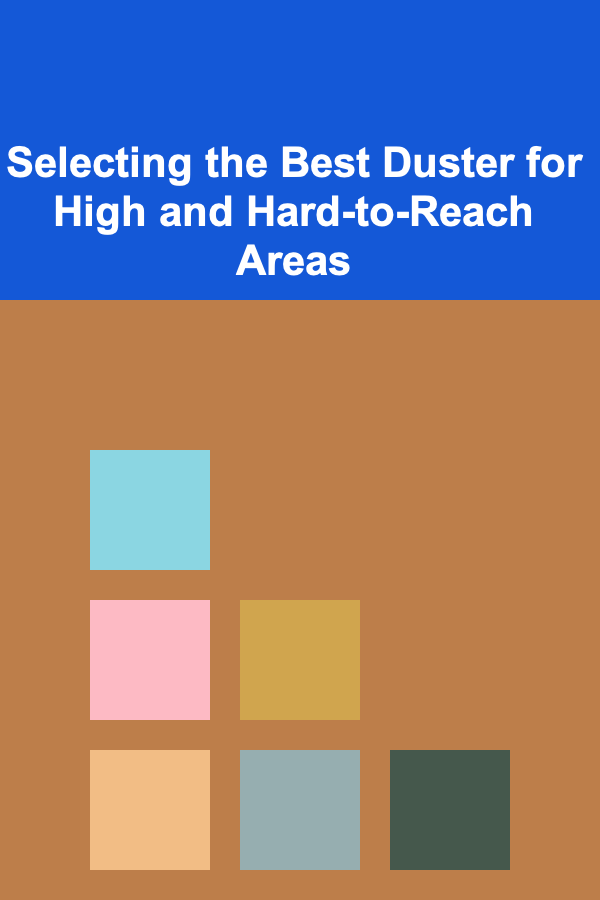
Selecting the Best Duster for High and Hard-to-Reach Areas
ebook include PDF & Audio bundle (Micro Guide)
$12.99$6.99
Limited Time Offer! Order within the next:

Dust, that ubiquitous fine powder of dead skin cells, fibers, pollen, and countless other microscopic particles, is a constant presence in our lives. While some might consider it a mere aesthetic nuisance, excessive dust accumulation can trigger allergies, exacerbate respiratory issues, and even damage delicate surfaces over time. Reaching those high and hard-to-reach areas -- the tops of bookshelves, ceiling fans, crown molding, light fixtures, and skylights -- presents a unique challenge. Traditional cleaning methods often fall short, requiring precarious balancing acts on ladders or the awkward maneuvering of bulky vacuums. Therefore, selecting the right duster is crucial for efficient and effective cleaning in these challenging spaces. This article will delve into the key factors to consider when choosing the ideal duster for high and inaccessible areas, exploring different types, materials, features, and usage techniques to help you maintain a dust-free and healthy environment.
Understanding the Challenge: Why High and Hard-to-Reach Areas Need Special Attention
Before diving into the specifics of duster selection, it's essential to understand why these areas often get neglected and why they require specialized cleaning tools.
Accessibility Issues
The primary challenge is, naturally, accessibility. Reaching high areas like ceilings and skylights typically requires a ladder or step stool. Hard-to-reach spots might include the narrow gaps behind furniture, the intricate details of decorative molding, or the confined space around light fixtures. Maneuvering cleaning equipment in these situations can be cumbersome, time-consuming, and even dangerous.
Dust Accumulation Hotspots
Certain high and hard-to-reach areas tend to accumulate more dust than others. This is often due to a combination of factors:
- Air Circulation: Areas near vents or air conditioning units can experience higher levels of dust circulation, leading to faster accumulation.
- Static Electricity: Surfaces like plastic or polished wood can attract dust through static electricity. This is especially common on electronic devices like televisions and computer monitors, which often reside on high shelves or mounted on walls.
- Lack of Disturbance: Areas that are rarely touched or cleaned provide a perfect environment for dust to settle undisturbed.
Health and Safety Concerns
Beyond aesthetics, accumulated dust can pose health and safety risks:
- Allergies and Respiratory Issues: Dust mites, a common component of household dust, are a major trigger for allergies and asthma. Breathing in dust-laden air can irritate the respiratory system and exacerbate existing conditions.
- Fire Hazard: Dust accumulating around light fixtures and electrical components can become a fire hazard, especially if the dust is flammable or contributes to overheating.
- Surface Damage: Dust can scratch delicate surfaces over time, particularly when wiped away with abrasive cloths. Furthermore, accumulated dust can trap moisture, leading to mold growth or corrosion.
Types of Dusters for High and Hard-to-Reach Areas
The market offers a wide variety of duster types, each with its own strengths and weaknesses. Understanding these differences is crucial for making an informed decision.
Extendable Dusters
Extendable dusters are perhaps the most versatile option for reaching high areas. They typically consist of a telescoping handle that can be extended to varying lengths, allowing you to reach ceilings, walls, and light fixtures without needing a ladder. The duster head can be made from a variety of materials, including microfiber, feathers, or electrostatic cloths.
Pros:
- Reach: The extendable handle provides excellent reach, making it ideal for high ceilings and walls.
- Versatility: Many extendable dusters come with interchangeable heads, allowing you to adapt to different cleaning tasks and surfaces.
- Convenience: Eliminates the need for ladders or step stools in most situations.
Cons:
- Maneuverability: Extended handles can be unwieldy and difficult to maneuver in tight spaces.
- Weight: Some extendable dusters can be heavy, especially when fully extended, making them tiring to use for extended periods.
- Storage: Can be bulky to store when fully extended.
Microfiber Dusters
Microfiber dusters are highly effective at trapping dust and dirt due to the unique structure of their fibers. Microfiber is made up of millions of tiny fibers that create a large surface area, allowing them to attract and hold dust particles more effectively than traditional cotton cloths.
Pros:
- Excellent Dust Removal: Microfiber excels at picking up and trapping dust, preventing it from simply being redistributed into the air.
- Washable and Reusable: Microfiber duster heads are typically machine washable, making them a cost-effective and environmentally friendly option.
- Gentle on Surfaces: Microfiber is soft and non-abrasive, making it safe for use on delicate surfaces like wood, glass, and electronics.
Cons:
- Can Attract Static Electricity: Microfiber can sometimes generate static electricity, which can attract more dust in the long run. Using a fabric softener during washing can help reduce static build-up.
- May Require Dampening: For heavily soiled areas, a slightly damp microfiber duster may be more effective at removing stuck-on dirt.
Feather Dusters
Feather dusters, particularly those made from ostrich feathers, have been a popular choice for dusting for centuries. The soft, flexible feathers are gentle on surfaces and can effectively reach into tight spaces.
Pros:
- Gentle on Delicate Surfaces: The soft feathers are ideal for dusting delicate items like antiques, artwork, and lampshades.
- Effective in Tight Spaces: The flexible feathers can reach into crevices and corners that other dusters may miss.
- Aesthetically Pleasing: Many people appreciate the traditional look and feel of a feather duster.
Cons:
- Can Redistribute Dust: Feather dusters tend to flick dust into the air rather than trapping it. This can be problematic for people with allergies or respiratory issues.
- Difficult to Clean: Feather dusters can be difficult to clean effectively. They often require hand washing and careful drying.
- Durability: Feather dusters can be fragile and may shed feathers over time.
Electrostatic Dusters
Electrostatic dusters use static electricity to attract and hold dust particles. They typically consist of a handle with a replaceable electrostatic cloth or a device that generates an electrostatic charge.
Pros:
- Effective Dust Attraction: The static charge effectively attracts and holds dust, preventing it from being redistributed into the air.
- Easy to Use: Electrostatic dusters are typically lightweight and easy to maneuver.
- Disposable Options: Many electrostatic dusters use disposable cloths, making cleaning convenient.
Cons:
- Reliance on Static Charge: The effectiveness of electrostatic dusters depends on the strength of the static charge. The charge can dissipate over time or in humid environments.
- Cost of Replacements: If using disposable cloths, the cost of replacements can add up over time.
- Not Ideal for Heavy Soiling: Electrostatic dusters are best suited for light dusting and may not be effective on heavily soiled surfaces.
Telescoping Pole Dusters with Bendable Heads
These dusters combine the reach of a telescoping pole with a flexible, bendable head. This allows you to adjust the angle of the duster to reach around corners, over the tops of cabinets, and other awkward spaces with greater ease.
Pros:
- Enhanced Reach and Flexibility: Combines reach with the ability to conform to different angles and shapes.
- Ideal for Complex Surfaces: Great for dusting crown molding, ceiling fans with curved blades, and other intricate architectural details.
- Reduces the Need for Repositioning: The bendable head allows you to clean a larger area without constantly adjusting your position.
Cons:
- Can Be More Expensive: These dusters tend to be pricier than simpler models.
- Flexibility Can Reduce Pressure: The bendable head may not apply as much pressure as a rigid head, potentially requiring more passes.
Vacuum Attachments
While not strictly "dusters," vacuum cleaner attachments designed for dusting are a valuable tool for cleaning high and hard-to-reach areas. These attachments typically include crevice tools, dusting brushes, and extension wands.
Pros:
- Powerful Dust Removal: Vacuums provide strong suction, effectively removing dust and debris from surfaces.
- Ideal for Large Areas: Vacuum attachments can quickly clean large areas like ceilings and walls.
- Versatile: Many vacuum cleaners come with a variety of attachments that can be used for different cleaning tasks.
Cons:
- Bulky and Cumbersome: Maneuvering a vacuum cleaner and its attachments in high or tight spaces can be challenging.
- Can Damage Delicate Surfaces: The strong suction of a vacuum cleaner can damage delicate surfaces or dislodge loose items.
- Noise: Vacuum cleaners can be noisy, which may be a concern in some situations.
Key Features to Consider When Choosing a Duster
Beyond the basic type of duster, several key features can significantly impact its effectiveness and usability.
Handle Length and Extendability
The handle length is a critical factor, especially for reaching high areas. Consider the height of your ceilings and the maximum reach you require. Extendable handles offer the greatest flexibility, allowing you to adjust the length as needed. Ensure that the handle is sturdy and easy to extend and retract.
Duster Head Material and Design
The material and design of the duster head determine its effectiveness at trapping dust and its suitability for different surfaces. Microfiber is a good all-around choice for its dust-trapping abilities and gentle nature. Feathers are best for delicate items, while electrostatic cloths are effective for attracting dust. Consider the shape and size of the duster head as well. A flat, wide head is ideal for cleaning large surfaces, while a smaller, more pointed head is better for reaching into tight spaces.
Weight and Balance
A lightweight and well-balanced duster is essential for comfortable and efficient cleaning, especially when working overhead. A heavy or unbalanced duster can be tiring to use and may make it difficult to control, increasing the risk of accidents.
Cleanability and Maintenance
Consider how easy the duster is to clean and maintain. Microfiber duster heads are typically machine washable, while feather dusters may require hand washing. Electrostatic duster cloths are often disposable. Choose a duster that is easy to clean and maintain to prolong its lifespan and ensure optimal performance.
Durability and Construction
A durable duster will withstand repeated use and last for many years. Look for a duster with a sturdy handle, a well-attached duster head, and high-quality materials. Read customer reviews to get an idea of the duster's durability and reliability.
Ergonomics and Grip
A comfortable grip is essential for preventing hand fatigue and ensuring precise control. Look for a duster with a handle that is ergonomically designed and provides a secure grip, even when wet.
Specific Scenarios and Duster Recommendations
The best duster for you will depend on the specific areas you need to clean and your personal preferences. Here are some recommendations for different scenarios:
High Ceilings and Walls
For cleaning high ceilings and walls, an extendable duster with a microfiber head is an excellent choice. The extendable handle provides the necessary reach, while the microfiber head effectively traps dust and dirt. Alternatively, a vacuum cleaner with an extension wand and dusting brush attachment can be used for a more thorough cleaning.
Ceiling Fans
Cleaning ceiling fans can be tricky, as dust tends to accumulate on the blades. A ceiling fan duster is specifically designed for this task. These dusters typically have a curved head that conforms to the shape of the fan blades, allowing you to clean them quickly and efficiently. Alternatively, an extendable duster with a microfiber head and adjustable angle can also be used.
Light Fixtures
Light fixtures can be delicate and difficult to reach. A feather duster is a good choice for dusting light fixtures, as the soft feathers are gentle on surfaces. Be sure to turn off the power to the fixture before cleaning. For more heavily soiled light fixtures, a slightly damp microfiber cloth can be used.
Crown Molding
Crown molding often has intricate details that can trap dust. A telescoping pole duster with a bendable head is ideal, or a smaller feather duster or a microfiber cloth wrapped around a paint stirrer can be used to reach into the crevices and corners.
Behind Furniture
Reaching behind furniture can be challenging. An extendable duster with a slim profile or a crevice tool attachment for your vacuum cleaner can be used to clean these areas. Alternatively, a long-handled dustpan brush can be used to sweep dust from behind furniture.
Skylights
Cleaning skylights often requires a combination of reach and maneuverability. An extendable duster with a swivel head is a good option, allowing you to adjust the angle of the duster to reach the skylight from different positions. A microfiber duster is also a great option here because it doesn't scratch the glass.
Tips for Effective Dusting in High and Hard-to-Reach Areas
Even with the right duster, proper technique is essential for effective cleaning.
Work from Top to Bottom
Always start dusting from the highest point in the room and work your way down. This prevents dust from falling onto already cleaned surfaces.
Use Slow, Deliberate Motions
Avoid quick, jerky movements that can stir up dust and redistribute it into the air. Use slow, deliberate motions to gently lift and remove dust from surfaces.
Dampen the Duster (If Appropriate)
For heavily soiled areas, slightly dampening the duster can help to loosen and remove stuck-on dirt. Be sure to use a clean, lint-free cloth and avoid over-wetting the duster, as this can damage some surfaces.
Shake or Clean the Duster Regularly
Shake the duster outdoors or over a trash can frequently to remove accumulated dust. Clean the duster head regularly according to the manufacturer's instructions.
Consider Air Quality
If you have allergies or respiratory issues, consider wearing a dust mask while dusting. You can also use an air purifier to remove airborne dust particles.
Regular Cleaning is Key
The most effective way to prevent dust accumulation in high and hard-to-reach areas is to clean them regularly. Aim to dust these areas at least once a month, or more frequently if needed.
Conclusion
Selecting the best duster for high and hard-to-reach areas is a crucial step in maintaining a clean, healthy, and aesthetically pleasing environment. By understanding the different types of dusters available, considering key features like handle length, duster head material, and weight, and employing proper dusting techniques, you can effectively tackle even the most challenging cleaning tasks. Remember to prioritize regular cleaning to prevent dust accumulation and enjoy the benefits of a dust-free home.
Reading More From Our Other Websites
- [Home Budget 101] How to Cut Household Expenses and Boost Your Savings
- [Organization Tip 101] How to Incorporate Smart Technology into Luxury Item Organization
- [Home Space Saving 101] How to Use Wall-Mounted Storage for Small Bathrooms
- [Personal Finance Management 101] How to Master Personal Finance for Small Business Owners: Separating Business and Personal Money
- [Home Cleaning 101] How to Clean a Showerhead: Restore Flow and Brightness
- [Organization Tip 101] How to Utilize Vertical Space for Pet Supply Storage
- [Home Holiday Decoration 101] How to Decorate Your Dining Room for a Festive Meal
- [Organization Tip 101] The Best Dust Collection Systems for a Clean and Safe Workshop
- [Home Family Activity 101] How to Explore Mindfulness Practices as a Family
- [Toy Making Tip 101] How to Launch a Niche Subscription Box Featuring One‑of‑a‑Kind Handmade Toys Each Month

How to Become a Confident Coder
Read More
How to Create a Gallery Wall Without Cluttering Your Space
Read More
How to Use Your Professional Experience to Build a Side Business
Read More
Understanding the Ethical Implications of Medical Breakthroughs
Read More
How To Provide Puzzle Toys for Mental Enrichment
Read More
10 Tips for a Yoga & Meditation To-Do List: Mind & Body Connection
Read MoreOther Products

How to Become a Confident Coder
Read More
How to Create a Gallery Wall Without Cluttering Your Space
Read More
How to Use Your Professional Experience to Build a Side Business
Read More
Understanding the Ethical Implications of Medical Breakthroughs
Read More
How To Provide Puzzle Toys for Mental Enrichment
Read More